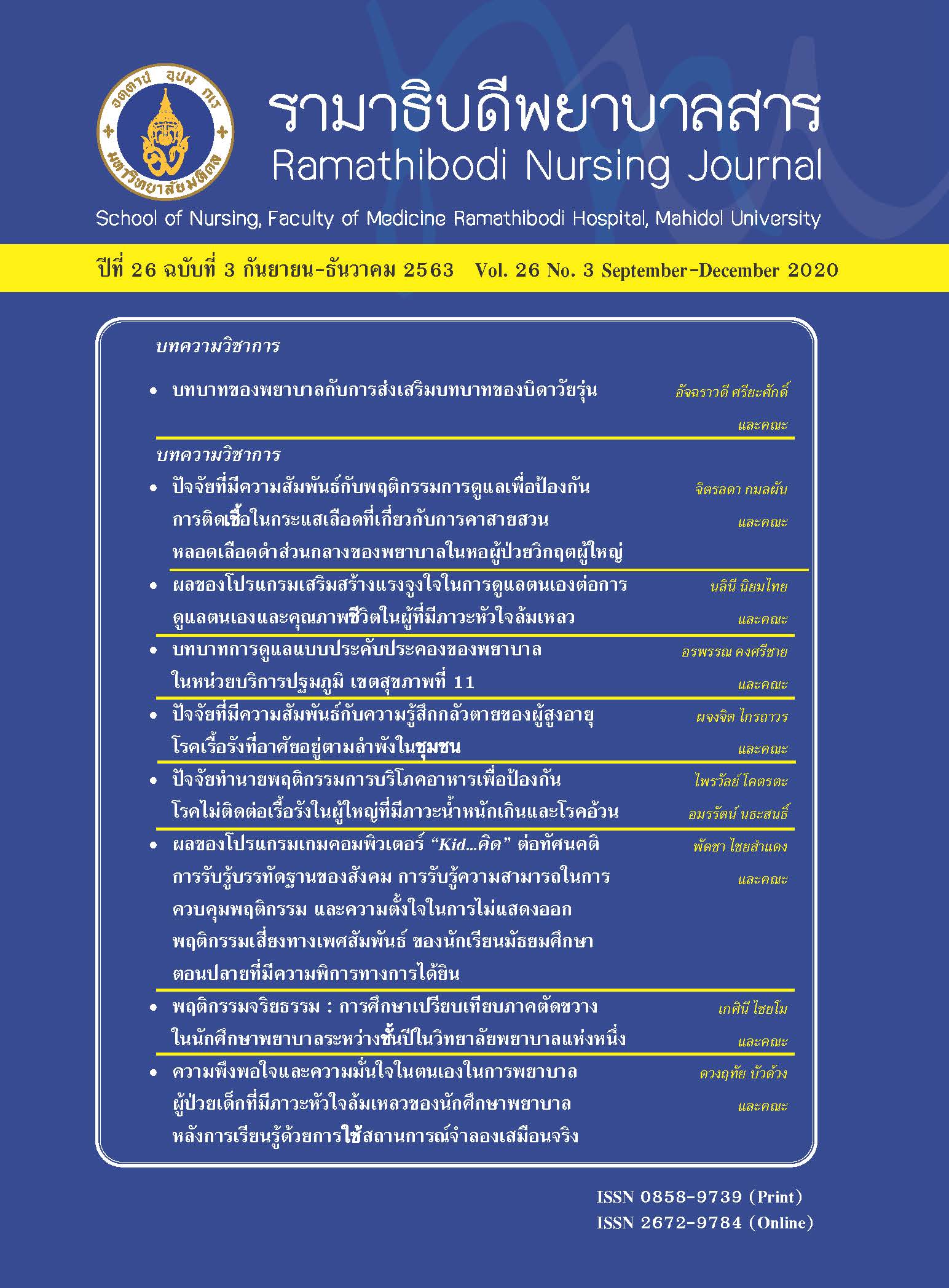ปัจจัยที่มีความสัมพันธ์กับพฤติกรรมการดูแลเพื่อป้องกันการติดเชื้อในกระแสเลือดที่เกี่ยวกับการคาสายสวนหลอดเลือดดำส่วนกลางของพยาบาลในหอผู้ป่วยวิกฤตผู้ใหญ่
Main Article Content
บทคัดย่อ
การวิิจััยเชิิงบรรยายครั้งนี้มีีวัตถุุประสงค์เพื่อศึึกษาความสัมพัันธ์ระหว่างความรู้ ทััศนคติิ การคล้อยตามกลุ่มอ้างอิิง และความตั้งใจในการปฏิิบััติิการพยาบาล กับพฤติิกรรมการดููแลเพื่อป้องกันการติิดเชื้อในกระแสเลืือดที่่เกี่่ยวกับการคาสายสวนหลอดเลืือดดำส่วนกลางของพยาบาลในหอผู้ป่่วยวิิกฤตโดยประยุุกต์กรอบแนวคิดทฤษฎีีพฤติิกรรมตามแผน กลุ่มตัวอย่างเป็็นพยาบาลที่่ปฏิิบััติิงานในหอผู้ป่่วยวิิกฤตและกึ่่งวิิกฤตผู้ใหญ่่ โรงพยาบาลรามาธิิบดีีจำนวน 184 ราย เครื่องมืือที่่ใช้้ในการศึึกษาครั้งนี้เป็็นแบบสอบถาม
เกี่ยวกับข้อมููลส่วนบุุคคล ความรู้ ทััศนคติิ การรับรู้การคล้อยตามกลุ่มอ้างอิิง ความตั้้งใจในการปฏิิบััติิการพยาบาล และพฤติิกรรมการดููแลเพื่่อป้องกันการติิดเชื้้อในกระแสเลืือดของพยาบาลในการดููแลผู้ป่วยที่่ได้รับการคาสายสวนหลอดเลืือดดำส่วนกลาง วิิเคราะห์ข้อมููล โดยใช้สถิิติิบรรยาย และสถิิติิวิิเคราะห์สหสััมพัันธ์ของเพีียร์สันผล การศึึกษาพบว่า กลุ่มตัวอย่างมีีความรู้ ทััศนคติิ การรับรู้การคล้อยตามกลุ่มอ้างอิิง และความตั้งใจในการปฏิิบััติิการพยาบาลอยู่ในเกณฑ์ดีี เมื่่อวิิเคราะห์ความสัมพันธ์ของตััวแปรพบว่่า ความรู้ ทััศนคติิ และการคล้อยตามกลุ่มอ้างอิิง มีีความสัมพัันธ์ทางบวกกัับความตั้้งใจในการปฏิิบััติิการพยาบาลอย่างมีีนัยสำคัญ
ทางสถิิติิ และความตั้งใจในการปฏิิบััติิการพยาบาลมีีความสัมพัันธ์ทางบวกกัับพฤติิกรรมการดููแลเพื่่อป้องกัันการติิดเชื้อในกระแสเลืือดที่่เกี่่ยวกับการคาสายสวนหลอดเลืือดดำส่วนกลางอย่างมีีนัยสำคัญทางสถิิติิ จากผลการศึึกษาครั้งนี้สามารถใช้เป็็นข้อมููลพื้นฐานในการส่งเสริิมพฤติิกรรมการปฏิิบััติิการพยาบาลเพื่่อป้องกันการติิดเชื้อในกระแสเลืือดที่่สััมพัันธ์กัับการคาสายสวนหลอดเลืือดดำส่วนกลางโดยการส่งเสริิมให้พยาบาลมีีความรู้ ทััศนคติิที่่ดีี และการคล้อยตามกลุ่มอ้างอิิง และความตั้้งใจในการปฏิิบััติิการพยาบาลในการป้องกัันการติิดเชื้้อดัังกล่าว
คำสำคัญ : ทััศนคติิ การคล้อยตามกลุ่มอ้างอิิง ความตั้งใจในการปฏิิบััติิการพยาบาล พฤติิกรรมการดููแล การติิดเชื้อในกระแสเลืือดที่่ เกี่่ยวกับการคาสายสวนหลอดเลืือดดำส่วนกลาง
Article Details
บทความ ข้อมูล เนื้อหา รูปภาพ ฯลฯ ที่ได้รับการตีพิมพ์ในรามาธิบดีพยาบาลสาร ถือเป็นลิขสิทธิ์ของวารสาร หากบุคคลหรือหน่วยงานใดต้องการนำทั้งหมดหรือส่วนหนึ่งส่วนใดไปเผยแพร่หรือเพื่อกระทำการใด ใด จะต้องได้รับอนุญาตเป็นลายลักษณ์อักษรจากรามาธิบดีพยาบาลสารก่อนเท่านั้น
เอกสารอ้างอิง
Dedunska K, Dyk D. Prevention of central venous catheterassociated bloodstream infections: a questionnaire
evaluating the knowledge of the selected 11 evidencebased guidelines by Polish nurses. Am J Infect Control
[Internet]. 2015;43(12):1368–71. [cite 2017 April17]. Available from: http://dx.doi.org/10.1016/j.ajic.2015.07.022
Lin KY, Cheng A, Chang YC, Hung MC, Wang JT, Sheng WH, et al. Central line-associated bloodstream infections
among critically-ill patients in the era of bundle care. JMicrobiol Immunol Infect [Internet]. 2015;(7):1–10.
[cite 2017 April 17]. Available from: http://dx.doi.org/10.1016/j.jmii.2015.07.001
Marschall J, Mermel LA, Fakih M, Hadaway L, Kallen A, O’Grady NP, et al. Strategies to prevent central lineassociated bloodstream infections in acute care hospitals:2014 update. Infect Control Hosp Epidemiol [Internet].2014;35(7):753–71. [cite 2016 December 9].Available from: http://www.scopus.com/inward/record.
url?eid=2-s2.0-84902969294&partnerID=tZOtx3y1
Ullman AJ, Long DA, Rickard CM. Prevention of central venous catheter infections: a survey of paediatric ICU
nurses’ knowledge and practice. Nurse Educ Today [Internet]. 2014;34(2):202–7. [cite 2016 August 8].
Available from: http://dx.doi.org/10.1016/j.nedt.2013.09.002
O’Grady NP, Alexander M, Dellinger EP, Gerberding JL,Heard SO, Maki DG, et al. Guidelines for the prevention
of intravascular catheter-related infections. Am J Infect Control. 2011;30(8):476–89.
Rickard CM, Courtney M, Webster J. Central venous catheters: a survey of ICU practices. J Adv Nurs.
;48(3):247–56.
Humphrey JS. Improving registered nurses’ knowledge of evidence-based practice guidelines to decrease the
incidence of central line-associated bloodstream infections: an educational intervention. J Assoc Vasc
Access [Internet]. 2015;20(3):143–9. [cite 2017 April 8]. Available from: http://www.sciencedirect.com/
science/article/pii/S1552885515000823
Labeau S, Vereecke A, Vandijck DM, Claes B, Blot SI,executive board of the Flemish Society for Critical Care
Nurses. Critacal care nurses’ knowledge of evidence-base Guideline for preventing infections associated with central venous catheters: An evaluation questionnaire. Am J Crit Care. 2008;17(1):65–71.
Yaseen M, Al-Hameed F, Osman K, Al-Janadi M, Al-Shamrani M, Al-Saedi A, et al. A project to reduce the
rate of central line associated bloodstream infection in ICU patients to a target of zero. BMJ Qual Improv Reports
[Internet]. 2016;5(1):u212545.w4986. [cite 2018 April 28]. Available from: http://qir.bmj.com/lookup/
doi/10.1136/bmjquality.u212545.w4986
Cabana MD, Rand CS, Powe NR, Wu AW, Wilson MH,Abboud PA, Rubin HR. Why don’t physicians follow
clinical practice guidelines?: a framework for improvement.JAMA. 1999 Oct 20;282(15):1458-65.
Podrazilová P, Hudáčková A. A comparison of nurses’knowledge of nursing care for central vascular catheters.Kontakt. 2015;17(4):e190–200.
Jeffery AD, Pickier RH. Barriers to nurses’ adherence to central venous catheter guidelines. J Nurs Adm [Internet].2014;44(7/8):429-35 7p. [cite 2016 August 8].Available from: http://search.ebscohost.com/login.aspx
?direct=true&db=cin20&AN=107871626&site=ehost-live
The Joint Commission. Preventing central line – associated bloodstream infections: a global challenge, a global perspective. 2012;136. [cite 2016 August 8]. Available from: http://www.jointcommission.org/assets/1/18/
CLABSI_Monograph.pdf
Ajzen I. The theory of planned behavior. Orgnizational Behav Hum Decis Process. 1991;50:179–211.
Bertani L, Carone M, Caricati L, Demaria S, Fantuzzi S,Guarasci A, et al. Using the theory of planned behavior to explore hospital-based nurses’ intention to use peripherally inserted central catheter (PICC): a survey study. Acta Biomed. 2016;87(1):23–9.
Dudeck MA, Weiner LM, Allen-Bridson K, Malpiedi PJ,Peterson KD, Pollock DA, et al. National Healthcare Safety
Network (NHSN) report, data summary for 2012,device-associated module. Am J Infect Control [Internet].
;41(12):1148–66. [cite 2016 August 8].Available from: http://dx.doi.org/10.1016/j.ajic.2013.09.002
Parra AP, Menárguez MC, Granda MJP, Tomey MJ,Padilla B, Bouza E. A simple educational intervention to
decrease incidence of central line-associated bloodstream infection (CLABSI) in intensive care units with low
baseline incidence of CLABSI. Infect Control Hosp Epidemiol. 2010;31(9):964–7.
Bruce N. Improving compliance with healthcare associated infection (HAI) practice guidelines to reduce the
acquisition of HAIs. Doctor of Nursing Practice (DNP) Projects, University of Massachusetts Amherst; 2003 [cite
April 28]. Available from: https://scholarworks.umass.edu/nursing_dnp_capstone/30
Bianco A, Coscarelli P, Nobile CGA, Pileggi C, Pavia M.The reduction of risk in central line-associated bloodstream infections: knowledge, attitudes, and evidence-based practices in health care workers. Am J Infect Control [Internet]. 2013;41(2):107–12. [cite 2016 August 8]Available from: http://dx.doi.org/10.1016/j.
ajic.2012.02.038
Appleby B. Exploring the value of an extended theory of planned behaviour model: to explain nurses’ and health care assistants’ instrumental research utilisation intentions in clinical practice, Doctoral dissertation, University of Birmingham; 2016
Koutzavekiaris I, Vouloumanou EK, Gourni M, Rafailidis PI, Michalopoulos A, Falagas ME. Knowledge and
practices regarding prevention of infections associated with central venous catheters: a survey of intensive care unitmedical and nursing staff. Am J Infect Control. 2011;39(7):542–7.
Wichmann D, Campos CE, Ehrhardt S, Kock T, Weber C, Rohde H, Kluge S. Efficacy of introducing a checklist
to reduce central venous line associated bloodstream infections in the ICU caring for adult patients. BMC infect
dis. 2018;18(1):1–6.
Piras SE, Minnick A, Lauderdale J, Dietrich MS, Vogus TJ. The effects of social influence on nurses’ hand hygiene behaviors. Nurs Adm. 2018;48(4):216-21
Boev C, Xia Y. Nurse-physician collaboration and hospital-acquired infections in critical care. Crit Care
Nurse. 2015;35(2):66–72.
Ko N-Y, Feng M-C, Chiu D-Y, Wu M-H, Feng J-Y,Pan S-M. Applying theory of planned behavior to predict
nurses’ intention and volunteering to care for SARS patients in southern Taiwan. Kaohsiung J Med Sci. 2004;20
(8):389–98.
Ab Malik N, Mohamad Yatim S, Lam OLT, Jin L, McGrath C. Factors influencing the provision of oral hygiene care following stroke: an application of the theory of planned behaviour. Disabil Rehabil [Internet].2018;40(8):889–93. [cite 2017 April 8]. Available from: https://doi.org/10.1080/09638288.2016.1277397
Gu JE, Ha YK, Hwang SH, Gong KH. Path Analysis of performance of multidrug-resistant organisms management guidelines among intensive care unit nurses: with focus on the theory of planned behavior and patient safety culture. J Korean Crit Care Nurs. 2018;11(1):89–100.
Ward DJ. The application of the theory of planned behaviour to infection control research with nursing and
midwifery students. J Clin Nurs. 2013;22(1–2):296–8.
Pasunon P. Reliability of Questionnaire in Quantitative Research. PRCJ. 2014;27(1):145-163. (in Thai)
Cook DA, Beckman TJ. Current concepts in validity and reliability for psychometric instruments: theory and
application. Am J Med. 2006;119(2):166.E7-E16.


